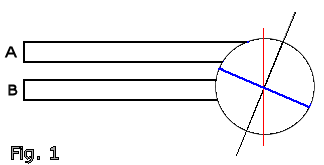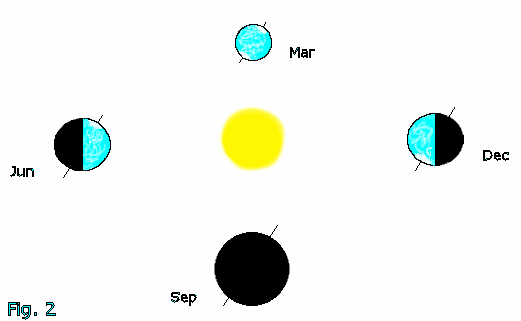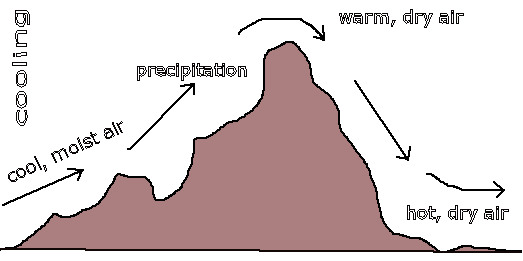
Some knowledge of the physics of climate is necessary to appreciate climate, weather, and biotic patterns. Weather systems and, on a large scale, climatic patterns are a result of
unequal heating of the earth's surface. Because of the tilt of the earth's axis relative to the pathway it takes on its circuit around the sun and the spheroidal shape of the earth, the angle of the sun's radiation hitting
any part of the earth changes throughout the year.
circuit around the sun and the spheroidal shape of the earth, the angle of the sun's radiation hitting
any part of the earth changes throughout the year.
In Fig. 1, the circle represents the earth, the blue line the equator, and the red line is 90° from the plane that would be formed by the path of the earth around the sun (the plane of the ecliptic). The black line passing through the earth is the axis of rotation of the earth; this is 23.5° from the plane of the ecliptic. At the distance of the sun from the earth, the sun's rays are essentially parallel. Two samples of the solar radiation are shown. The samples are of equal width. In A, the insolation is hitting the earth's surface at an angle because of the curvature of the earth; in B, the sun's rays are essentially perpendicular to the surface. It should be clear that the heat provided by A is being spread over a much larger area than that provided by B, and since the amount of heat is the same for both A and B, then any given unit of area of A is receiving less heat than the same sized area of B.
The earth is a huge gyroscope: its axis points to the same spot (in the north, very close to Polaris, the North Star) regardless of where it is in its revolution around the sun.
This means that at one time of the year the North Pole will be pointing 23.5° away from the sun (the winter solstice in the  northern hemisphere); at some 6 months later, 23.5° toward the sun (summer solstice), and at various
intermediate orientations between those two extremes. On the first day of spring and the first day of fall, the North and South poles will be equally distant from the sun (spring and fall
equinoxes). In Fig. 1, the North Pole is pointing away from the sun; it is summer in the southern hemisphere, and the heat from the sun is hitting perpendicular to the surface (23.5° south of
the equator: the Tropic of Capricorn); in the northern hemisphere, the North Pole is in darkness, the light extending northward only to the Arctic Circle (23.5° from the North Pole; this is
marked by the intersection of the red line with the earth's surface). On the first day of summer in the northern hemisphere, the situation would be opposite: the sun would be directly overhead at
the Tropic of Cancer, the North Pole would have light 24 hours a day, and the area south of the Antarctic Circle would be in darkness. Figure 2 shows the earth in relation to the sun at the
solstices (December, June) and equinoxes (March, September).
northern hemisphere); at some 6 months later, 23.5° toward the sun (summer solstice), and at various
intermediate orientations between those two extremes. On the first day of spring and the first day of fall, the North and South poles will be equally distant from the sun (spring and fall
equinoxes). In Fig. 1, the North Pole is pointing away from the sun; it is summer in the southern hemisphere, and the heat from the sun is hitting perpendicular to the surface (23.5° south of
the equator: the Tropic of Capricorn); in the northern hemisphere, the North Pole is in darkness, the light extending northward only to the Arctic Circle (23.5° from the North Pole; this is
marked by the intersection of the red line with the earth's surface). On the first day of summer in the northern hemisphere, the situation would be opposite: the sun would be directly overhead at
the Tropic of Cancer, the North Pole would have light 24 hours a day, and the area south of the Antarctic Circle would be in darkness. Figure 2 shows the earth in relation to the sun at the
solstices (December, June) and equinoxes (March, September).
Coriolis Force. Matter, whether solid, liquid, or gas, that moves in relation to the earth's surface is subject to the Coriolis Force because of the spin of the earth. The effect is to cause the material to curve to the right in the northern hemisphere and to the left in the southern. We can demonstrate the principle by considering a body (again, solid, liquid, or gas) at the equator. The surface of the land at the equator is moving at roughly a thousand miles per hour as the earth rotates from west to east. Everything at the equator is moving at roughly the same speed. On the other hand, a body at the pole would merely rotates one turn every 24 hours.
If you could instantly teleport a person (who is traveling at a speed of some 1000 miles per hour) from the equator to about half way to the North Pole, that person on arrival would abruptly zip away eastward at about 500 miles per hour since the earth's surface at that point is only moving at about 500 miles per hour. (Star Trek never mentioned this, did it?) More or less the same thing happens when air, for example, moves poleward; it is going faster than the earth below and thus (from the earth's surface point of view) is displaced to its right (eastward). On the other hand, something moving south is going to be going slower than the earth's surface and thus be displaced westward (that it, seem to curve to the right from the earth-surface point of reference). The opposite occurs south of the equator; going from fast in the north (close to the equator) to the slower rotation to the south, the object will appear from the surface of the earth to curve to the left (east). The phenomenon can be generalized to different directions and relative speeds.
Why consider this here? Because it's the Coriolis force that results in the spinning of high and low pressure atmospheric systems. As air rushes in to a low pressure system, it curves to its right as it begins to move toward the center of the low pressure; however, as it approaches the low pressure area, the pressure differential draws it in to its left; the compromising result is that air circulates around a low in a counterclockwise direction. Air rushing away from a high pressure system likewise curves to the right, resulting in a clockwise circulation system (and, of course, opposite in the southern hemisphere). In regard to summer precipitation in the Chihuahuan Desert, the clockwise spinning Bermuda High moves north and westward over the Atlantic in summer, with air from its southern side (and thus an easterly wind) being directed to the southern USA. At the same time, the interior deserts of North America heat up, producing a continental low pressure area; the combination of the flows from the Bermuda High and the continental low results in a southerly flow of air over the desert Southwest and adjacent Mexico, drawing moist air from the Gulf of California, the Sea of Cortez (Gulf of California), and Pacific. The result is the so-called Monsoon Season of the Southwest.
Humidity. We've all heard the comment, "It's not the heat, it's the humidity". Actually, it's the relative humidity. Absolute humidity is the amount of moisture in a
given parcel of air. Relative humidity is the amount of moisture relative to the amount that could be stored in that parcel of air given the temperature of the air. The warmer the air, the more
moisture it can hold, and vice versa. Thus an absolute humidity that results in 100% relative humidity at a low temperature may result in a relative humidity of, say, 15% at 102°F. Evaporative
water loss is strongly influenced by the relative humidity. Water loss by plants, animals, soil, etc., may be negligible in high humidity; at low humidity, it may be life threatening. Since
temperate- and tropical-zone deserts typically have low humidity (especially during the hot season), adaptations to prevent water loss are critical for most desert organisms. 
Orographic Precipitation. Orographic refers to the effects of mountains. As moving air encounters mountains, it is forced to rise; as air moves upward, it expands; expansion of a gas such as air cools the gas (the same amount of heat is now in a larger volume). As noted with the humidity section, the amount of moisture that can be held by a parcel of air depends on the air temperature; as air cools, its relative humidity rises, and if the cooling is great enough, the air cannot hold all of its moisture, resulting in clouds and precipitation. The change from the gaseous form of water to the liquid form is condensation, and condensation releases heat (this is the opposite process to evaporation, which absorbs heat). The result is that if air cools sufficiently as it's forced to rise by mountains, precipitation occurs on the windward side, resulting in loss of moisture and concomitant increase in temperature of the now drier air. As the air descends on the leeward side, it once more is compressed and, having gained heat from condensation, now is hotter than when it started out. Aside from the air being hotter, it also has lost moisture through precipitation; this hot, dry air is unlikely to undergo further precipitation and its low relative humidity readily evaporates any available moisture. When the effect is strong, such as with the Sierra Nevada, Sierra Madre Occidental, and Sierra Madre Oriental, the result is a strongly marked rain shadow on the leeward side. Smaller ranges also can have rain shadows, though of lesser extent.
Cloud Cover. Hot, dry air is unlikely to form much in the way of cloud cover. Clouds tend to reflect heat radiated from the surface of the earth, as well as reflecting a portion of incoming insolation. The result of scarcity of clouds in a desert area is rapid heating during the day and rapid cooling during the night, resulting in the classic large differential between daytime and nighttime temperatures.
Convection. With the lack of a good plant cover that tends to restrict ground heating, rocks and soil in the desert heat up rapidly and transfer much of the heat to the air immediately adjacent to the surface. Warm air expands and thus is lighter in weight than any surrounding, cooler air; like a hot air balloon, such parcels of air rise. Movements of air currents because of differential temperatures (and thus weights) is convection. As a parcel of air rises, it expands and, as it expands, cools (as noted in the section on orographic precipitation). With sufficient differential between such a bubble of air and the surrounding air, the parcel may eventually expand to the point that moisture begins to condense (thus the puffy cumulus clouds often seen). Condensation, as noted above, produces heat. If the initial upward impetus plus the additional heat being produced by condensation is sufficient, the parcel may remain warmer (and thus more buoyant) than the surrounding air and continue to rise, giving rise to the thunderstorms that provide most of the Chihuahuan Desert summer rains.
Last Update: 26 Jun 2006